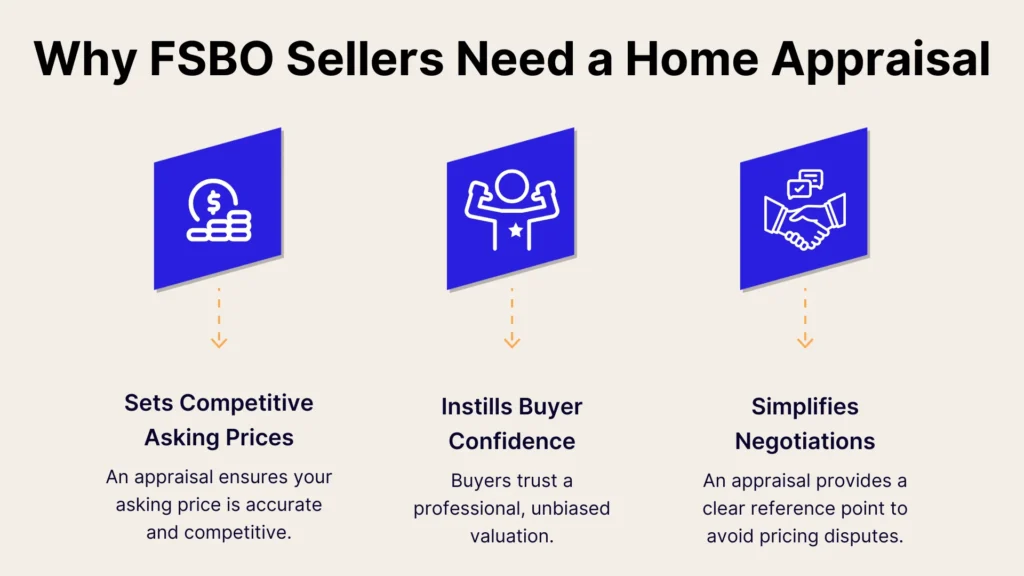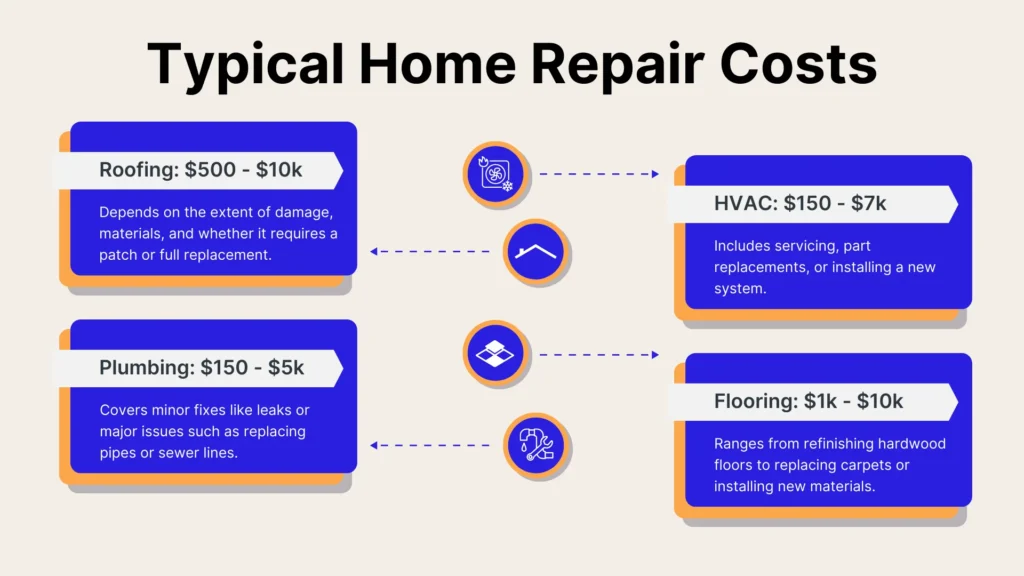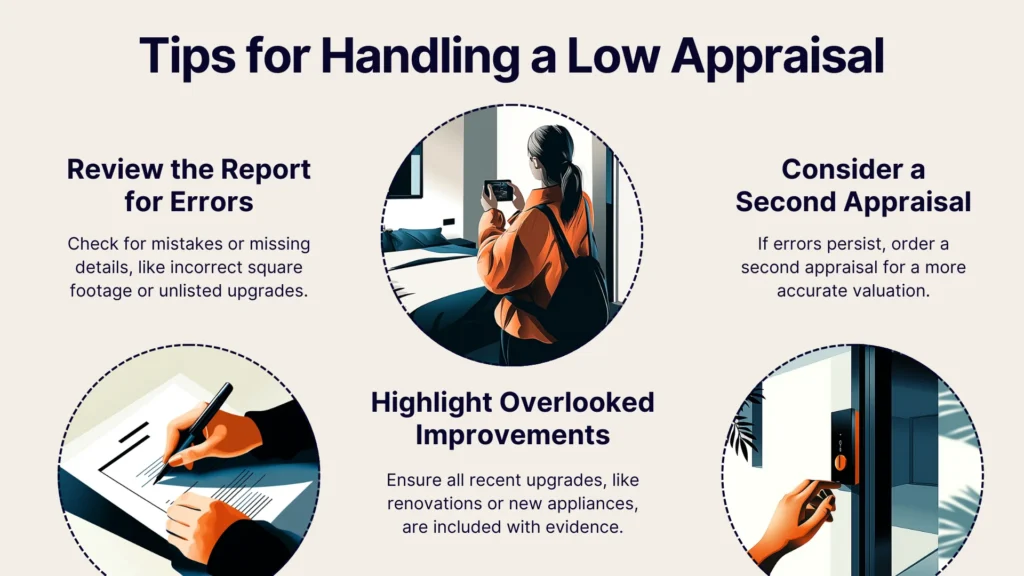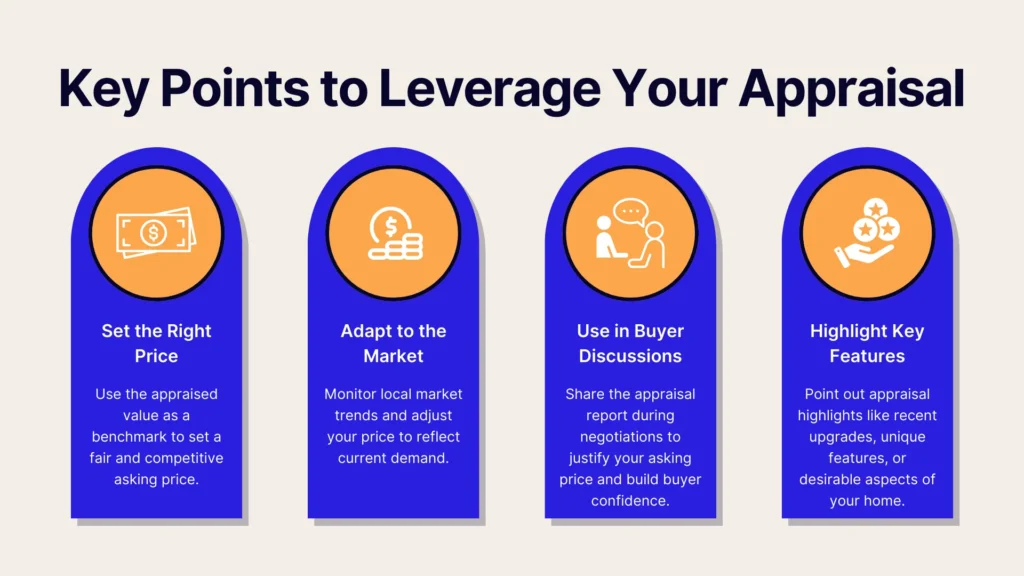Selling your home without the help of a real estate agent – also known as For Sale By Owner or FSBO – can be an empowering and rewarding experience. One of the most critical steps in this process is obtaining an accurate home appraisal. But how do you get one, and what happens during this process?
Understanding the home appraisal process and its role in the selling journey can significantly impact your ability to set a competitive price and attract serious buyers. This guide will walk you through the home appraisal process, offering practical tips so you can prepare for and leverage a favorable appraisal.
What Is A Home Appraisal?
A home appraisal is a professional evaluation of a property's value conducted by a licensed appraiser. This unbiased assessment considers various factors, including the property's condition, location, and market trends, to determine its fair market value.
Appraisers assess both tangible and intangible aspects, such as the physical condition of the property and its proximity to amenities. Home appraisals are often required by lenders during the mortgage approval process, but they are equally important for FSBO sellers to price their property accurately and competitively in the real estate market.
Why Is A Home Appraisal Important For FSBO Sellers?
For FSBO sellers, a home appraisal provides a reliable estimate of the property's worth. This information is crucial for setting a competitive asking price, ensuring the home is neither undervalued nor overpriced. An accurate appraisal instills confidence in buyers, as they can trust the valuation established by an impartial professional.
An appraisal streamlines negotiations by providing a clear reference point that reduces the chances of disputes over price. Furthermore, a properly aligned appraisal helps avoid financing complications by ensuring that the buyer's lender approves the loan based on the appraised value.

How To Prepare For A Home Appraisal
Preparing your home for an appraisal is essential to maximizing its value. Follow these steps to ensure your property makes the best possible impression:
Declutter And Clean The Property
First impressions matter, and a clean, organized home creates a positive impression on the appraiser. By decluttering living spaces, tidying up closets, and thoroughly cleaning every room, you highlight the property's potential and make it appear well-maintained.
Cleaning showcases key features like countertops, flooring, and appliances, which might go unnoticed in a cluttered or untidy environment.
Make Necessary Repairs
Minor and major repairs alike can significantly influence the appraised value. For instance, ensure that doors and windows operate smoothly, as sticking or misaligned fixtures can signal underlying issues. Replace broken or foggy windowpanes and repair damaged doorframes to enhance functionality and aesthetic appeal.
Additionally, attend to squeaky floors or loose tiles, as these can detract from the overall perception of quality. Regular maintenance and addressing these less obvious repair needs can have a cumulative positive impact on your appraisal.

Fix Leaks And Electrical Issues
Leaky faucets and outdated electrical systems can create a negative impression and lower your home's appraised value. Address these issues before the appraisal to demonstrate that the property is well-maintained. Ensuring these systems are in optimal working order reflects positively on the appraiser's evaluation.
Repair Cracks In Walls And Ceilings
Visible cracks in walls and ceilings can indicate potential structural issues, even if minor. These should be repaired and repainted to enhance the property’s appearance and structural integrity. A clean, polished look reassures the appraiser of the home’s quality.
Document Upgrades And Improvements
Keeping detailed records of recent upgrades and improvements is critical for demonstrating the value you’ve added to your home. Proper documentation helps the appraiser understand how these enhancements impact the overall value of the property and ensures they are fully considered during the evaluation.
List Recent Renovations And Their Costs
Compile a comprehensive list of all recent renovations, such as a kitchen remodel, bathroom upgrades, or additions like a deck or new flooring. Include the associated costs for each project. This list demonstrates the financial investment made in the property and provides the appraiser with concrete data to factor into the valuation.
Include Before And After Photos
Visual documentation, such as before-and-after photos, is an excellent way to showcase the impact of renovations and improvements. These images provide tangible evidence of the enhancements, making it easier for the appraiser to assess the added value. Highlight key areas where significant upgrades were made to draw attention to the property’s improved condition.
What Happens During A Home Appraisal?
Understanding what occurs during the appraisal process can help you feel more prepared. Here are the main steps:
Examination of Home Exterior
The appraisal begins with an evaluation of the home’s exterior. The appraiser will examine the structure’s size, design, and condition to assess its curb appeal and overall build quality. Features such as siding, paint, windows, and architectural style are also considered in the evaluation. A well-maintained exterior creates a favorable impression and contributes positively to the appraised value.
Evaluation of The Condition Of The Roof And Foundation
The roof and foundation are critical components of a home’s structural integrity. The appraiser inspects these areas for signs of wear, damage, or potential repair needs. A solid roof free of leaks and a stable foundation without visible cracks assure the appraiser of the home’s durability and long-term reliability.
Examination of Landscaping And External Features
Landscaping and other external features, such as patios, fences, and driveways, contribute to the property’s value. Well-kept landscaping adds aesthetic appeal and indicates that the property has been cared for. External amenities like outdoor kitchens or pools may enhance the home’s desirability and market value.
Inspection of Home Interior
The home’s interior is scrutinized to assess its layout, functionality, and overall condition. The appraiser evaluates the condition of walls, ceilings, and floors to ensure they are well-maintained and free of damage. Room sizes are measured to determine utility, and spaces are assessed for flow and usability. Modernized kitchens and bathrooms with ample storage contribute positively to the interior evaluation.
Assessment of Home Systems’ Functionality
Essential HVAC, plumbing, and electrical systems are inspected to confirm they are in good working order. The appraiser ensures that these systems meet safety standards and function efficiently. For instance, an operational and up-to-date HVAC system adds to the home’s value by reducing future maintenance costs for potential buyers.
Appraiser Evaluates Comparable Sales
Using comparable sales, or “comps,” the appraiser benchmarks the property’s value against similar homes that have recently sold in the area. Comps provide context for market trends and help establish a fair valuation for the property.
Home Valuation Is Adjusted Based On Appraisal and Market Trends
As a final step, the appraiser adjusts the valuation based on market conditions, unique property features, and any additional findings from the inspection. This ensures that the appraised value reflects the home’s physical characteristics and position within the broader real estate market.
Understanding The Appraisal Report
After the appraisal, the appraiser provides a detailed report outlining the property’s appraised value and the factors influencing it. Key factors such as location, size, condition, and unique features of the home play a significant role in determining the final valuation. FSBO sellers should also distinguish between the market value, which reflects the price buyers are willing to pay, and the physical condition of the property as assessed by the appraiser. Understanding this distinction helps sellers better position their homes in the market.
What To Do If The Appraisal Is Lower Than Expected
A low appraisal can be challenging, but it doesn’t have to derail your sale. If you find yourself in this situation, there are several steps you can take to address the issue effectively and ensure your property is valued accurately:

Look For Errors Or Missing Information
Start by carefully reviewing the appraisal report for any errors or missing details. Sometimes, appraisers may overlook critical information, such as the correct square footage of the property or recent upgrades you’ve made. Identifying and correcting these inaccuracies is essential to ensuring a fair valuation. Gather the necessary documentation if you spot discrepancies and bring it to the appraiser’s attention.
Check For Overlooked Improvements
Double-check that all recent upgrades and improvements to your home have been accounted for in the appraisal. If some enhancements, such as new appliances, a renovated bathroom, or energy-efficient upgrades, were missed, provide the appraiser with a list of these improvements along with supporting evidence, such as receipts and photos. These overlooked details can significantly impact the appraised value.
Consider Getting A Second Appraisal
If you strongly disagree with the initial appraisal, you may want to consider ordering a second appraisal. This can be particularly helpful if the first appraisal contained significant errors or failed to reflect key aspects of your property.
Keep in mind that obtaining a second opinion may involve additional costs, so it’s important to weigh the potential benefits against the expense. A new appraisal might provide a more favorable valuation and help you move forward with your FSBO sale.
How To Use A Favorable Appraisal In Your FSBO Sale
A favorable appraisal provides a strong foundation for your FSBO sale. It gives you a reliable, professional valuation of your home that can be used to guide your pricing and negotiation strategies effectively.

Use The Appraisal Value As A Benchmark For A Favorable Price
The appraised value serves as a reliable benchmark for setting your asking price. Pricing your home close to the appraised value can attract serious buyers who recognize the property’s worth. This strategy also reduces the risk of overpricing, which can deter potential buyers and prolong the selling process.
Adjust Based On Market Conditions And Interest
While the appraisal provides a solid starting point, it’s important to remain flexible. Monitor market conditions and adjust your pricing strategy as needed. For example, if the market is highly competitive, you might consider setting your price slightly above the appraisal to test buyer interest. Conversely, staying closer to the appraised value in a slower market can help your home stand out.
Leverage Appraisal In Negotiations
The appraisal report is a powerful tool during negotiations. Share it with potential buyers to justify your asking price and build their confidence in the property’s value. Highlight key findings from the appraisal that demonstrate the home’s strengths, such as recent upgrades or desirable features. By leveraging the appraisal, you can negotiate from a position of strength and reach a favorable agreement more quickly.
Conclusion
The home appraisal process is an important step for FSBO sellers. A well-executed appraisal ensures an accurate valuation and builds confidence among potential buyers, streamlining your path to closing the deal. With careful preparation and attention to detail, you can make the appraisal process work to your advantage and maximize your home’s value in the FSBO market.
Turn your home appraisal into a competitive advantage with Propbox. Our platform ensures you're fully prepared, from organizing renovation records to leveraging AI-powered valuation tools. Avoid the 6% commission, sell faster, and retain control throughout the FSBO process. Experience the Propbox difference and maximize your home’s potential today!
